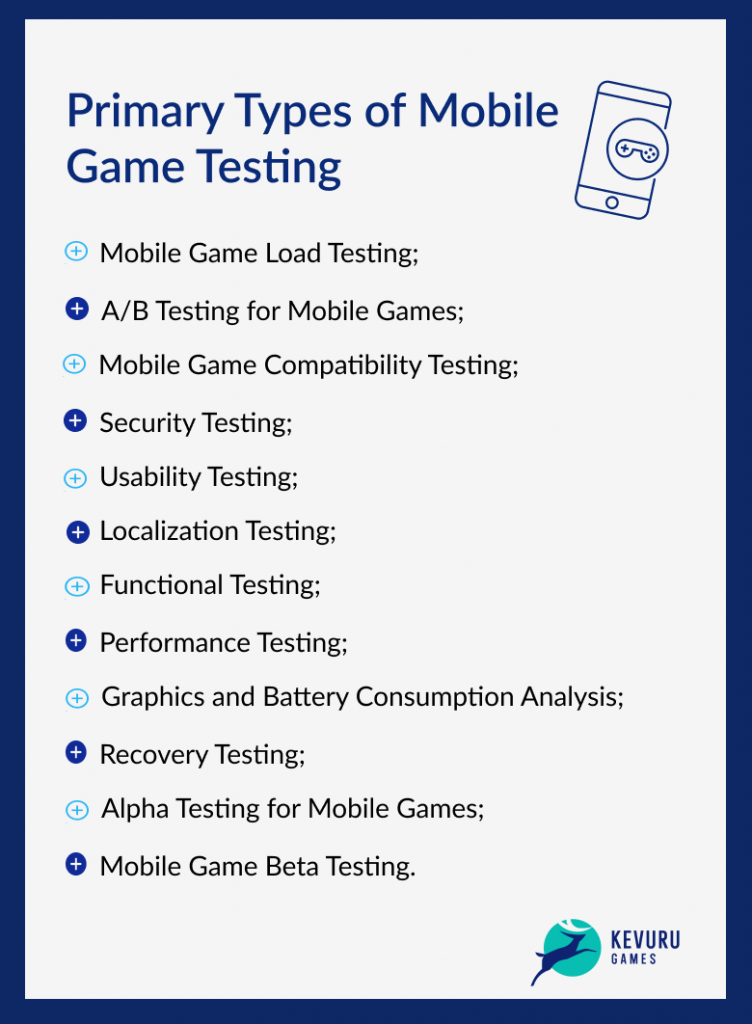Are you about to release a new mobile game, or trying to figure out how to reduce production costs for an upcoming big title?Then consider the importance of game testing. Testing is essential when it comes to releasing a successful and bug-free video game. It guarantees that all features work correctly and that players won’t experience any issues with stability, performance, payment systems etc. Let’s discuss mobile game testing: from the basics like best practices for running tests.
What is mobile game testing and why it’s important
It’s a crucial step in the development process of any game. This process involves evaluating the quality of a game on various devices, checking its compatibility, and ensuring it runs smoothly on different systems. With the rise in popularity of mobile gaming, it’s important for developers to have a tool to test their game before it’s released. The aim of testing is not only to identify the bugs but also to improve the overall gaming experience. Understanding the significance of mobile game testing can make a difference in the success or failure of a game project.
Identifying Risk Factors in Game Market Launches
In the competitive and ever-changing world of video game development, plenty of factors can make or break a launch. Identifying the risk factors that can lead to a game’s failure is more important than ever. Research shows that a lack of marketing, poor timing of launch, and unfavorable reviews are among the top reasons why games fail. However, risk factors can vary depending on the specific game genre and target audience. Identifying and mitigating these risk factors is essential to navigating the complex game market and maximizing a game’s potential.

Exploring the Primary Types of Mobile Game Testing
Testing mobile games is a vital part of the mobile game development process. It helps identify and resolve issues that may otherwise affect the user experience. Different types of testing are designed to serve a specific purpose. While these types differ in their approach, they all share a common goal: to ensure that mobile games deliver users a smooth and enjoyable experience.
| Mobile Game Load Testing | As mobile gaming continues to grow in popularity, it’s vital to ensure a seamless user experience. One crucial aspect of this is mobile load testing, which involves assessing a game’s ability to handle heavy traffic and usage. By putting a game through load testing, developers can identify and address any potential performance issues. |
| A/B Testing for Mobile Games | A/B testing has emerged as a powerful tool to optimize the gaming experience, by testing different variations of the game to see which version resonates more with users. This process involves showing different versions of the game to different groups of users and measuring engagement levels to determine the success of each variation. By utilizing A/B testing methods, developers can make data-driven decisions to enhance the overall gaming experience and keep players coming back for more. |
| Mobile Game Compatibility Testing | It’s an essential step in making sure that games work perfectly on all mobile devices. With the increasing number of mobile platforms available in the market, it’s crucial to thoroughly test games to ensure that they run smoothly and do not crash. Compatibility testing covers a lot of ground, including graphics, resolution, audio, controls, and gameplay. By doing this testing, game developers can also validate that the game is playable in all locations and on all network configurations. This level of thorough testing is particularly important as it ensures that the games are error-free and provide an optimal user experience. |
| Security Testing | As technology continues to advance, security threats become more complex and difficult to anticipate. That’s why security testing has become an essential part of software development and maintenance. By simulating potential attacks, developers can identify vulnerabilities and strengthen the system’s defenses. But it’s not just about identifying security flaws; it’s also about ensuring that the software meets regulatory standards, protects user data, and keeps pace with evolving threats. With the rise of remote work and cloud computing, security testing has never been more critical. It’s a crucial step in creating and maintaining dynamic, secure, and efficient software systems that can withstand even the most sophisticated attacks. |
| Usability Testing | Usability testing is a critical component in the user experience design process. It involves testing a product, such as a website or app, with a group of users to collect feedback and make necessary improvements. By conducting usability testing, designers can ensure that their product is aesthetically pleasing and user-friendly, as what may seem intuitive to designers may be completely confusing to users. It helps bridge that gap and creates a product that truly matches the needs and wants of its intended audience. Ultimately,this type enables designers to create a better product that provides a positive user experience. |
| Localization Testing | One of the key components of software testing is localization testing. This process involves software product evaluation in different geographical regions, languages, and cultures to ensure it meets the specific requirements of that area. Localization testing is essential to ensure that software applications are not only functional, but also culturally appropriate and understandable. For instance, a software application designed for customers in the United States may not adequately meet the needs of customers in Europe or Asia. Output language code, such as EN-US, is a crucial component of software localization testing, as it ensures that software products are accurately translated into the language of the target region, making the product more user-friendly and accessible for customers. |
| Functional Testing | It is a process that ensures that a software application operates as expected, while also meeting customer requirements. This process checks the software application’s functionality, user interface, performance, security, and compatibility, amongst other critical factors. Functional Testing is a necessary step in the software development life cycle to ensure the user gets a high-quality product that performs to its fullest potential. By conducting this type of tests, the development team can identify and fix issues before launch, saving both time and resources in the long run. |
| Performance Testing | When it comes to developing software applications, one aspect that cannot be overlooked is performance testing. Essentially, this involves subjecting the app to a range of simulated scenarios to see how well it will perform under different conditions. This testing is crucial in ensuring that the final product is stable, responsive, and meets the needs of users. By highlighting any weaknesses or bottlenecks that may exist in the system, performance testing helps developers to optimize the app, improving its speed, reliability, and overall user experience. |
| Graphics and Battery Consumption Analysis | The graphics and battery consumption of any device are two key factors that users consider before purchasing. Graphics play an important role in enhancing the user experience, while battery consumption affects the longevity of the device. Therefore, understanding the relationship between the two is crucial for optimal device performance. Through detailed graphics and battery consumption analysis, one can evaluate how different applications use graphics and the impact on battery life. This analysis can help developers optimize their applications for better performance and reduced battery consumption. |
| Recovery Testing | This type is designed to simulate data loss or infrastructure failures to test the system’s ability to recover quickly and effectively. Recovery testing is essential in identifying potential weaknesses in a system and allowing developers to make improvements before any actual disasters occur. By performing this type of testing regularly, businesses can help minimize downtime and ensure that their systems are always up and running smoothly. |
| Alpha Testing for Mobile Games | It is an essential step in the game development, especially for mobile games that reach millions of users worldwide. During this stage, a selected group assesses the game for functionality, stability, and user experience. This allows the development team to identify and fix any bugs or glitches before the game is released to the public. In addition to technical issues, alpha testers also provide valuable feedback on gameplay, graphics, and the overall fun factor of the game. This feedback helps refine and improve the game product, ensuring it is a smash hit when it finally reaches the market. |
| Mobile Game Beta Testing | With so much competition, game developers need to release a polished and well-tested game that will keep players coming back for more. That’s why beta testing has become an essential step in the game development process. By releasing a beta version of their game, developers can gather feedback from real players and make improvements before the full release. This not only improves the overall quality of the game but also helps to avoid negative reviews and poor user engagement. |

Overcoming Challenges in Mobile Game Testing
A meticulous approach to testing, identifying bugs, and fixing them promptly can be challenging, so developers can overcome them with the right attitude, tools, and strategies. By prioritizing user experience, focusing on the game mechanics, and getting feedback from users, developers can ensure their games are successful and enjoyable for players worldwide. It may be a difficult task, but with dedication and attention to detail, the challenges of mobile game testing can be overcome.
Addressing Security Concerns
In today’s rapidly changing digital landscape, addressing security concerns has become more crucial than ever. As technology continues to advance, cyber threats are becoming more sophisticated and frequent, making it crucial for individuals and organizations to stay vigilant to protect their sensitive information. From identity theft to data breaches, security threats can lead to devastating consequences – loss of funds, reputation, time, and resources. To address security concerns effectively, it is essential to keep up with the latest cybersecurity trends and technologies, and to implement stringent security measures to safeguard your data. By prioritizing cybersecurity, we can mitigate the risks of security breaches and protect ourselves from harmful cyber attacks.
User Interface Evaluation
User interface evaluation is a crucial aspect of software development that helps to determine the usability and accessibility of a particular application. The evaluation process involves analyzing how easy it is for a user to navigate through an interface and accomplish their intended tasks. This can be achieved through various methods such as usability testing, heuristic evaluation, and user feedback. By conducting a thorough evaluation, developers can identify any existing issues and make necessary improvements to create a seamless user experience. This ultimately leads to increased user satisfaction and a higher adoption rate for the software.
Identifying Common Bugs in Games
Have you ever been playing a game and encountered a pesky bug that ruins your experience? Bugs in games can range from minor graphical glitches to game-breaking crashes. Identifying these bugs is an important step in ensuring a smooth and enjoyable gameplay experience. One common bug is the infamous “invisible wall” where the player is unable to progress due to an invisible barrier blocking their path. Another common bug is the “physics glitch” where objects in the game world behave in an unexpected way, such as floating in mid-air or bouncing erratically. By identifying and reporting these bugs to the game developers, players can help improve the overall quality of the game. So the next time you encounter a bug in a game, don’t get too frustrated – take note and help make the game better for everyone.
Key Metrics in Mobile Game Testing
Mobile games have been around for quite some time now and have taken the gaming industry by storm. The demand for mobile game testing has grown significantly, and so has the need to measure key metrics during the testing phase. Metrics such as gameplay experience, user acquisition, retention, revenue, and engagement are critical to the success of any mobile game. Game testers need to ensure that the game functions well, user interfaces are intuitive, and the overall gaming experience is enjoyable. Key metrics are essential in determining the success of a mobile game, as they play a crucial role in making prompt decisions and improving user experience and overall game performance.

Tips for Effective Mobile Game Testing
Mobile gaming is an ever-growing industry, and it’s essential to ensure that games are thoroughly tested before they hit the market. Testing mobile games is no easy feat, but it can be effective with the right tips and tricks. With our advice in mind, you’ll be sure to produce quality games that users will enjoy playing.
- Test across multiple devices with varying specs and hardware. This way, you can catch any performance issues or compatibility problems that may arise.
- Involve beta testers and take their feedback seriously. They can help you identify bugs and glitches that you may have missed.
- Always test with the user experience in mind. Game testing is not just about ensuring that the game runs smoothly but also that it’s enjoyable to play and meets the expectations of your target audience.
Overview of Top Mobile Game Testing Tools
Testing is a crucial stage in the development of any mobile game. It ensures that the game is bug-free, playable, and enjoyable for the game’s users. To make this possible, developers use a variety of tools. Some of the top game testing tools include Appium, XCUITest, Earlgrey, and Espresso. With these tools, developers can test the game for functionality and performance across different devices and operating systems. Additionally, they can detect and fix any bugs in the game before it is released to the public.
Kevuru Games Expertise in Mobile Games Testing
At Kevuru Games, as a mobile game testing company, we take great satisfaction in our broad experience and fruitful partnerships with major gaming companies, which enable us to manage project pipelines and uphold standards of excellence flawlessly. Our systematic and open approach guarantees that our clients are informed and involved at every turn, providing a comprehensive understanding of the work’s progress and outcomes. This is a synopsis of our established procedure:
1. Analysis of needs: We review the project specifications carefully. Our committed staff gets to know our clients’ needs, vision, and goals through close collaboration. We guarantee that our work matches the client’s expectations and establishes a solid basis for the development process by thoroughly understanding the project objectives.
2. Determination of test data: We carefully ascertain the data required for testing at this stage. To show the test data necessary to assess the game’s functionality, performance, and user experience, we examine the project specifications, the game mechanics, and the intended results.
3. Carefully planning the test strategy’s development: Our QA specialists plan the test strategy. It entails specifying the testing scope, figuring out the necessary testing kinds (functionality, performance, compatibility, etc.), and selecting the testing frameworks and tools.
4. Test Execution: After deciding on a test plan, we start the test. Our skilled QA team thoroughly tests the game using pre-established test cases and situations. Using manual and automated testing processes, we assess the game’s functionality, performance, compatibility, and overall user experience.
5. Analysis and comparison of expected and actual outcomes: Following test execution, we compare the expected and actual results. Thanks to this study, we can find any disparities, inconsistencies, or performance gaps. This meticulous comparison guarantees that the game fulfills the needs of the consumer and the intended quality criteria.
6. Test and bug reports: To keep our customers informed about the testing procedure and the progress of any problems discovered, we strongly emphasize thorough and open reporting. We offer test reports with information on the outcomes, flaws, and severity level. Our reports give the development team a clear understanding of the game’s quality and allow them to resolve any faults found quickly.
7. Test Regression: Following bug fixes, we retest the game to ensure that the fixes do not introduce new problems and that the general stability and functionality of the game are preserved.
Kevuru Games offers a full-cycle of game development, as we can provide various services for our clients to ensure that they receive a top-notch game. From the initial idea to the finest intricacies of game management, we have it all covered. We offer a wide range of mobile game development services, including:
- Fully executed development;
- Concept art;
- 2D and 3D art creation;
- Level design;
- Quality assurance and testing;
- Post-release support.

Final Thoughts
Mobile game testing is crucial to game development as it can identify potential risk factors, improve the user experience, ensure security, and optimize performance. By including thorough testing in the development process, teams can keep up with market demands and create high-quality mobile games that provide users with a great experience. With the right tools and processes in place to manage pre and post-launch game testing, organizations have the best chance of success on the market. With regular planning, proper execution and dedication to quality assurance procedures, development teams can guarantee exceptional results when launching a mobile game in today’s crowded market platform.










![Indie Game Development: Guide to Revenues, Most Profitable Genres & Monetization [+10 Best Indie Games 2024]](https://kevurugames.com/wp-content/uploads/fly-images/11949/indie-pre-138x138.jpg)